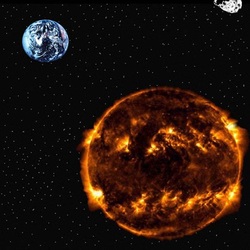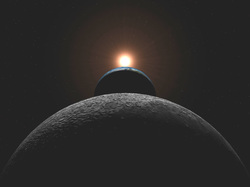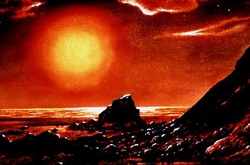Our Sun

The sun, the provider of life and a god in many religions and beliefs, keeps us humans on our planet alive. It gives us warmth, energy and also represents hope. However, can this bringer of life also be the forerunner of death? Our Sun is the biggest thing in our galaxy, dwarfing all the planets. In fact, our sun makes up 99.8% of the mass in our galaxy. The other 0.2% is all of our planets, asteroids and moons. That is how big the Sun is. In other words, you can fit 1 million objects the size of Earth, and still have space to fit Jupiter and Saturn, the two biggest planets in our solar system. Out of all the stars in the universe, our Sun is in the top 10% for its mass. It is tiny compared to supergiants, which can be up to 20 times the mass of our Sun, and about 135,000 times as much energy. The centre of the Sun is 15 million degrees Celsius. Our Sun burns hydrogen to create heat and light.
What are the effects of having no Sun, and has this happened before?

Our sun gives energy in the form of heat and light. The heat helps us keep warm against the bitter cold of space. The light is what allows us too see. Without the Sun, life would be very different. The only heat and light source would be fire and electricity. We would have to live underground because it would be very cold. Underground, the temperature would be very cold, but at least better than the surface. We would only be able to eat earthworms and moles, because there are no plants. The plants need the energy from the Sun to grow, so if there wasn't a Sun, there would be no plants. There would be hardly any animals, because many animals live on plants, and carnivores live on other animals. This has never happened before, otherwise our planet would’ve probably already been eradicated and humans would’ve never had the chance to evolve.
How might the Sun die?

Our Sun is about a third way through its life span. It feeds on hydrogen energy and slowly turning it into helium. The hydrogen atoms are located close to the core. After about 1.1 million years from now, the Sun will increase to about 10%, burning us to death if we haven’t moved to other planets yet. 5.4 million years after that, our Sun will double in size and finish burning all the hydrogen in its core. It will start burning hydrogen from around its core. 1.5 million years later, our Sun will increase to about 166 times its size, swallowing Mercury, Venus and Earth. By this time it will be a red giant. When our Sun consumes all of the available hydrogen, it will shrink in size and start consuming helium. However, this will last our Sun only another 100 million years. 12 billion years from now, our Sun will peel off the crust, mantle and outer core, leaving only the core left. The core is nowhere near as bright or warm as the Sun is now. It will only be roughly the size of our planet. This is what we call a White Dwarf star, and will remain for a few more billion years, until its fuel runs out, leaving only a trace of gas. That gas is all that will remain of our Sun.
Likelihood
This is the only way we might get wiped out that is likely. Our Sun will, of course, die in a few billion years time, and the last races of humanity would’ve probably been wiped out, but we could’ve moved to other planets. Our Sun, when it is a red giant, could just explode in a supernova and destroy us all, instead of the white dwarf scenario. Then after the supernova, a gamma-ray burst that signals a black hole could destroy our planet (see the page Gamma-Ray bursts) and if it misses us or we survive that, we will probably be vacuumed up by the black hole. So my likelihood for the Sun (or any Sun related disasters):
7.75/10
7.75/10
